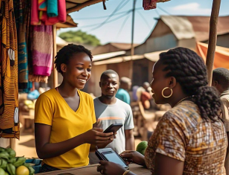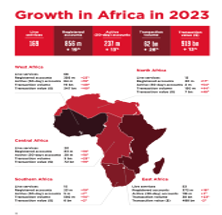By: Ebenezer ASUMANG
“The most effective barrier for the success of mobile money around the world is the banking lobby”
———–Bob Collymore, ex-CEO at Safaricom – Kenya
Mobile money has transformed the global financial services landscape, providing a cost-effective, transparent, and empowering way for individuals and businesses to manage their finances (GSMA, 2020).
This innovation was first popularized by Safaricom and Vodafone’s M-Pesa (where “M” stands for “mobile” and “pesa” means “money” in Swahili) in Kenya, which launched in 2007. Half of the mobile money services in the world are located in Africa. More specifically, the sub-Saharan African region has led the way in mobile money for years.

Consequently, the continent continues to be the global leader in mobile money services (Senyo, P.K., 2021). When the COVID-19 pandemic began its “devastation” worldwide in the early 2020s, it quickly became clear that mobile technology, and mostly mobile money, would have an outsized role in keeping people connected, delivering vital financial support, and providing safe, contactless.
ways to pay for food, electricity, and other life essentials. Mobile money even become a part of a new daily routine for millions around the world.
Mobile Money – a digital wallet for cashless transactions
According to World Remit, Mobile money is a technology that allows people to receive, store and spend money using a mobile phone.
It is sometimes referred to as a ‘mobile wallet’ or by the name of a specific service such as M-Pesa, EcoCash, Tigo Pesa and many more. This includes payments (such as peer-to-peer transfers), finance (such as insurance products), and banking (such as account balance inquiries).
Even though mobile phones are central to plenty of different uses, mobile money is more than just technology – a cash-in, cash-out infrastructure is needed, usually accomplished through a network of “cash merchants” (or “agents”), who receive a small provision for turning cash into electronic value (and the other way around). (Donovan, 2012).
Mobile money is stored in a secure electronic account linked to a mobile phone number. Sometimes the mobile number is the same as the phone number, but not always. Mobile money is often offered by the same companies that operate the country’s mobile phone services and is available to both prepaid and contract customers.
With the help of this system, mobile money users can store, send, and receive money with their mobile phones.
Items in shops or online can be bought, school fees and bills can be paid, and top-up mobile airtime can be made easily. In case a user wants to pay a bill or send money to another person, they simply select the relevant service from their phone’s mobile money menu. It is as simple as sending a text message (World Remit, 2020).
Macroeconomic Reflections – Mobile Money Economy
(GSMA, 2024) posits that mobile money has had a significant positive impact on lives and livelihoods in many of the countries where these services operate.
Beyond improving financial inclusion and access to other digitally enabled services, the adoption, use and growth of mobile money are now reflected in macroeconomic indicators: an increase in mobile money adoption can lead to a rise in GDP. Between 2013 and 2022, a 10-percentage point rise in mobile money adoption was found to have increased GDP by 0.4%-1.0%

Africa`s frontrunners in Mobile Money adoption
Mobile money services have spread rapidly in many developing countries. However, only a handful of these initiatives have reached a sustainable scale. The Philippines in Southeast Asia was one of the early adopters of mobile money services as of 2001 when SMART Communications launched SMART Money.
There has also been GCASH for that matter. However, Africa has made giant strides since that time with countries like Kenya, South Africa, Tanzania, Uganda, Zambia, Cote d’Ivoire, Ghana and others.
Kenya: M-Pesa. With M-Pesa, Kenya is at the forefront of the mobile money revolution. According to the Communication Commission of Kenya (2013), 24.8 million subscribers hooked up to mobile money services like M-Pesa.
A survey by Pew Research Centre (2013) further stressed that the number of Kenyans using mobile wallets to make or receive payments was higher than any of the 24 countries surveyed.
The M-Pesa application is installed on the SIM cards of customers and works on all handset brands. Registration is free and users do not need to have a bank account.
Safaricom charges a withdrawal and transfer fee but keeps a free mobile wallet deposit. The transfer service was quickly picked up for use as an informal savings account system and electronic payment mechanism for bills, goods and services.
South Africa [MTN Mobile Money]: This was launched in 2005 as a joint venture between the country’s second-largest network operator MTN and a large commercial bank, Standard Bank.
Tanzania [Airtel]: This operator was the first mobile network to introduce a phone-to-phone airtime credit transfer service “Me2U” in 2005 (Intermedia, 2013).
The operator partners with Citigroup and Standard Chartered Bank to provide m-money services including bill payments, payments for goods & services, phone-to-phone and phone-to-bank money transfers and mobile wallets.
Vodacom Tanzania launched the second East African implementation of the Vodafone m-money platform, M-Pesa.
Uganda [MTN]: The first operator to launch mobile money services in 2009 and it remains by far, the market leader (Intermedia, 2012). By law, each mobile money provider has to partner with a bank. However, users do not need a bank account to use mobile money services.
Ghana [MTN MoMo/Vodafone Cash/Airtel tiGO Cash]: Ghana initially lagged behind other African countries when it came to mobile money adoption, after the introduction of mobile money services by MTN in 2009, but fast forward to 2020, and Ghana became the fastest-growing mobile money market in Africa (Mobile Money Africa, June 2021).
Cote d’Ivoire [Orange/MTN]: These have competed head-to-head in the mobile money market (CGAP, 2012). Orange Money was launched in 2008 by Orange in partnership with BICICI (BNP Paribas), and MTN Mobile Money was launched in 2009 by MTN in partnership with SGBCI (Société Générale) (GSMA, 2014).
Some mobile money benefits
There are numerous reasons, why mobile money is an attractive alternative to traditional cash payment for users (Wireless World, 2021). A few are outlined below:
- Financial inclusion for everyone:Mobile Money can be transferred almost anywhere. It is an effective way to provide access to finance to millions of people around the globe, who were previously excluded from the formal financial system – especially those in rural areas of developing countries.
- Cashless payment:The “contactless” or “cashless payment” decreases the dependency on cash and allows the tracking of transaction records, which increases financial security and reduces inherent risks of cash handling for instance loss, theft or fraud.
- Lower transaction costs:Compared to credit cards, mobile money has lower transaction costs.
- Increased transparency:With this solution no middlemen for transferring money are required, which increases transparency to the customer.
- Fast transaction:Long travels to send and receive money or to pay bills by standing in long queues are avoided, in other words, a fast and comfortable alternative way for the traditional financial transaction has been established.
Conclusion
As Africa’s mobile money (MoMo) story continues to unfold, it is clear that this innovative technology has transitioned from being a marginal phenomenon to a mainstream driver of financial inclusion and economic growth.
With over a decade of remarkable progress from humble beginnings in 2007, mobile money has not only bridged the financial gap for millions of Africans but has also created new opportunities for entrepreneurship, employment, and socio-economic development.
The success of mobile money in Africa serves as a testament to the power of innovation, collaboration, and regulatory foresight.
As the continent continues to evolve and grow, stakeholders, including governments, operators, and development partners must remain committed to nurturing this ecosystem, addressing emerging challenges, and harnessing the full potential of mobile money to drive sustainable development.
As we look to the future, it is clear that Africa’s mobile money story is only just beginning. With the advent of new technologies, such as 5G, artificial intelligence, and blockchain, the possibilities for mobile money to drive even greater impact and transformation are vast.
As we turn the page on this chapter, we must remain focused on ensuring that the benefits of mobile money are equitably distributed and that this technology continues to serve as a powerful tool for inclusive growth, poverty reduction, and socio-economic development across Africa.
The African Continental Free Trade Area (AfCFTA) can leverage this low-hanging fruit to harness opportunities in job creation and fair trade for Africa`s unstoppable youthful population and to create a conducive atmosphere for them to thrive.
References
Osabutey et al, (May 2024) Mobile money and financial inclusion in Africa: Emerging themes, challenges and policy implications. Technological Forecasting & Social Change Journal. Volume 202
GSMA, (2024) The State of the Industry Report on Mobile Money.
https://www.gsma.com/sotir/wp-content/uploads/2024/03/GSMA-SOTIR-2024_Report.pdf
[Accessed April 1, 2025]
Kitimbo, A., (2021) Mobile money and financial inclusion of migrants in sub-Saharan Africa
https://www.elgaronline.com/edcollchap/book/9781839100611/book-part-9781839100611-29.xml [Accessed April 1, 2025]
Senyo, P.K.,( 2021) Ghana’s new mobile money rule could derail financial inclusion. But there are answers. https://theconversation.com/ghanas-new-mobile-money-rule-could-derail-financial-inclusion-but-there-are-answers-158770 (Accessed April 1, 2025)
Muellbauer, J., et al (2019) The Economics of Mobile Money: harnessing the transformative power of technology to benefit the global poor
https://oms-www.files.svdcdn.com/production/downloads/May-19-OMS-Policy-Paper-Mobile-Money-Aron-Muellbauer.pdf [Accessed March 30, 2025]
Donovan, P.K., (2012) Mobile Money, More Freedom? The Impact of M-PESA’s Network Power on Development as Freedom. International Journal of Communication. Volume 6
ABOUT THE WRITER
Ebenezer is a PhD Media and Communication student specialising in Development Communication. His research interests include climate change adaptation, community radio, environmental sustainability, communication for social change, development journalism, and the green economy.
Connect with him via: [email protected] / [email protected]
LinkedIn: Ebenezer Asumang. [ https://www.linkedin.com/in/ebenezer-asumang/ ]










